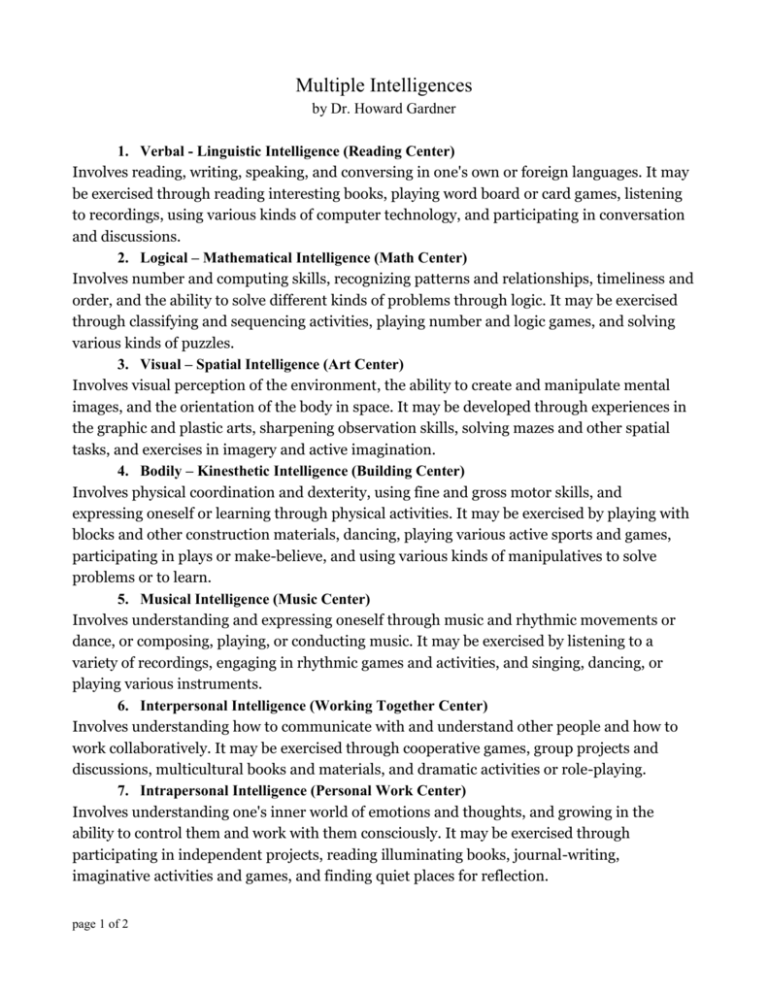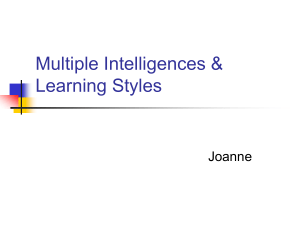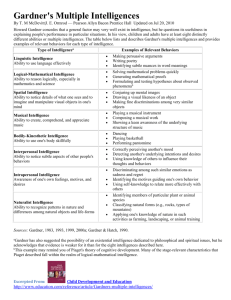1 - Brain Injury Alliance of Oregon
advertisement

Multiple Intelligences by Dr. Howard Gardner 1. Verbal - Linguistic Intelligence (Reading Center) Involves reading, writing, speaking, and conversing in one's own or foreign languages. It may be exercised through reading interesting books, playing word board or card games, listening to recordings, using various kinds of computer technology, and participating in conversation and discussions. 2. Logical – Mathematical Intelligence (Math Center) Involves number and computing skills, recognizing patterns and relationships, timeliness and order, and the ability to solve different kinds of problems through logic. It may be exercised through classifying and sequencing activities, playing number and logic games, and solving various kinds of puzzles. 3. Visual – Spatial Intelligence (Art Center) Involves visual perception of the environment, the ability to create and manipulate mental images, and the orientation of the body in space. It may be developed through experiences in the graphic and plastic arts, sharpening observation skills, solving mazes and other spatial tasks, and exercises in imagery and active imagination. 4. Bodily – Kinesthetic Intelligence (Building Center) Involves physical coordination and dexterity, using fine and gross motor skills, and expressing oneself or learning through physical activities. It may be exercised by playing with blocks and other construction materials, dancing, playing various active sports and games, participating in plays or make-believe, and using various kinds of manipulatives to solve problems or to learn. 5. Musical Intelligence (Music Center) Involves understanding and expressing oneself through music and rhythmic movements or dance, or composing, playing, or conducting music. It may be exercised by listening to a variety of recordings, engaging in rhythmic games and activities, and singing, dancing, or playing various instruments. 6. Interpersonal Intelligence (Working Together Center) Involves understanding how to communicate with and understand other people and how to work collaboratively. It may be exercised through cooperative games, group projects and discussions, multicultural books and materials, and dramatic activities or role-playing. 7. Intrapersonal Intelligence (Personal Work Center) Involves understanding one's inner world of emotions and thoughts, and growing in the ability to control them and work with them consciously. It may be exercised through participating in independent projects, reading illuminating books, journal-writing, imaginative activities and games, and finding quiet places for reflection. page 1 of 2 8. Naturalistic Intelligence Involves understanding the natural world of plants and animals, noticing their characteristics, and categorizing them; it generally involves keen observation and the ability to classify other things as well. It may be exercised by exploring nature, making collections of objects, studying them, and grouping them. Dr. Howard Gardner, author of Frames of Mind and co-director of Project Zero at Harvard University, has created a Theory of Multiple Intelligences. He points out that school [and traditional rehabilitation] systems often focus on a narrow range of intelligence that involves primarily verbal/linguistic and logical/mathematical skills. While knowledge and skills in these areas are essential for surviving and thriving in the world, he suggests that there are at least six other kinds of intelligence that are important to fuller human development and that almost everyone has available to develop. They include, visual/spatial, bodily/kinesthetic, musical, interpersonal, naturalist and intrapersonal intelligence. Gardner believes that the eight intelligences he has identified are independent, in that they develop at different times and to different degrees in different individuals. They are, however, closely related, and many teachers and parents are finding that when an individual becomes more proficient in one area, the whole constellation of intelligence may be enhanced. For this reason, we believe that it is important to encourage children [and people in recovery] to explore and exercise all of their intelligences. Creating a rich, nurturing, and stimulating environment filled with interesting materials, toys, games, and books lays the foundation for healthier, happier, brighter children [and adults in recovery]! Students who have these kinds of experiences know many ways to learn almost anything! In 1983, Howard Gardner introduced his Theory of Multiple Intelligences in a seminal book, Frames of Mind. Based on his work as professor in the Harvard Graduate School of Education, his work as a psychologist researching brain injuries, and his long interest and involvement in the arts, he suggested that intelligence is not a single attribute that can be measured and given a number. He pointed out that I.Q. tests measure primarily verbal, logical-mathematical, and some spatial intelligence. Believing that there are many other kinds of intelligence that are important aspects of human capabilities, he proposed that they also include visual/spatial, bodily/kinesthetic, musical, interpersonal, and intrapersonal intelligences. More recently he added naturalist intelligence to this list and suggested that there may be other possibilities including spiritual and existential. About the Author: Dee Dickinson is CEO of New Horizons for Learning and co-author, with Linda MacRae Campbell and Bruce Campbell of Teaching and Learning Through the Multiple Intelligences. (1996, 1999 Allyn & Bacon.), which is available as a resource for those interested in applying Dr. Howard Gardner's Theory of Multiple Intelligences in the classroom. Copyright © 1996, 1998, 2000, 2001, 2002 New Horizons for Learning P O Box 31876 Seattle WA 98103 USA (360) 786-1833 http://www.newhorizons.org info@newhorizons.org page 2 of 2





